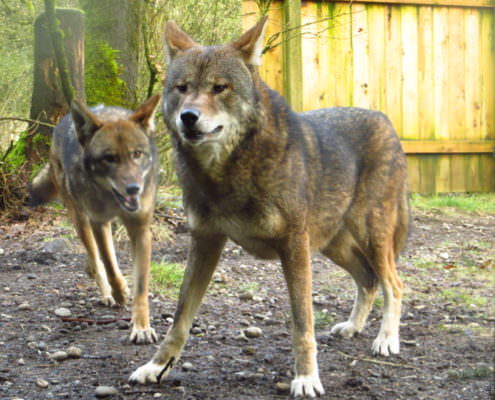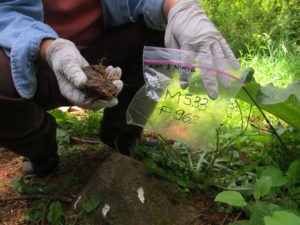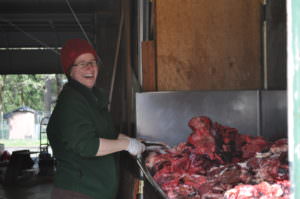What It’s Like to Work With Wolves (part 4 of a 5-part series)
What’s that smell? by Brennan Stoelb, Animal Care Specialist, Wolf Haven International
Even if our clothes stay dry, they are not out of the woods yet. Our clothes are constantly subjected to the various aromas we encounter on a daily basis. I’ll use today as an example. For our Species Survival Plan (SSP) enclosures, we do fecal clean-ups every other day. It was decided that fecals would be done at the same time that we did rounds (when everyone gets fed). So, this morning Pamela and I did routine fence line work in Ruby and Tala’s (two red wolves) enclosure. We set the barrel full of woodchips down for a second and then continued towards are work area, where I dumped a pile of chips to spread. I began to notice that something didn’t smell right. My hand was muddy, but mud doesn’t smell like this. I then looked at my pant leg and found some more unsettling news. Apparently when we set the barrel down, we set it on a pile of excrement, which was conveniently placed by the bottom handle so I could grab it and then rub it against my leg. For one last bit of information, consistency changes depending how much raw meat an animal consumes……we’ll leave it at that.
I’ve mentioned in a previous blog (“Barrel O’ Fun” posted Oct 2, 2013) about the meat donations from a local retailer through the Sustainable Solutions through Quest Recycling program. Basically, this is a donation of a variety of unsold meat, so imagine what those meats smell like. Other sources of meat include fresh road kill. Yes, that’s right. We only feed road kill that is relatively fresh, no maggots or other predatory evidence being present, to our SSP residents. We often freeze the deer when they arrive to kill off any ticks or other parasites that may be present. We then thaw the animal and divide it up. This includes legs and carcass often going to different enclosures. I will leave it at that. After a couple of days, the remnants are then removed from the enclosures.
This also goes for salmon, pumpkins etc. Wolves will often cache things and you can imagine what a salmon smells and looks like after basking in the sun, partially buried.
Bottom line, sanitizer is our friend. (to be continued…)
Up Next: Why Work with Wolves? – the final installment of the series




you guys are awesome, thank u for all u do for these animals:)